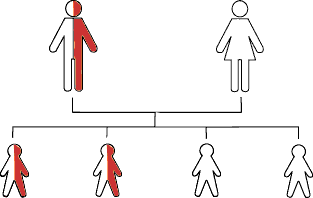FREQUENTLY ASKED QUESTIONS ON THALASSAEMIA
What is thalassaemia?
Thalassaemia is an inherited blood disease which is transmitted by a gene. It reduces the amount of
haemoglobin your body can make, thus causing anaemia.
What is anaemia?
If you have too few red blood cells, or there is too little haemoglobin in them, you have anaemia. The most common
is iron deficiency anaemia. This can happen if you don't have enough iron in your diet. It can be cured by
taking iron medicine. Thalassaemia is an inherited anaemia. It CANNOT be cured by taking any
medicine.
How is thalassaemia inherited?
The thalassaemia gene is passed on from parent to child.
1. If both parents have the thalassaemia traits, the following can occur:

- Chance of having a child with thalassaemia major is 25%
- Chance of having a child with the thalassaemia trait is 50%
- Chance of having a normal child is 25%
2. If only one parent has the thalassaemia trait, the following can occur:

- Chance of having a child with the thalassaemia trait is 50%
- Chance of having a normal child is 50%
From a pamphlet issued by MOH, Singapore.
What is thalassaemia trait?
A person who has one thalassaemia gene is said to have the thalassaemia trait. He or she remains healthy
but can pass on the gene to his or her children. There are about I million people with thalassaemia trait in
Malaysia. They are sometimes called "carriers of thalassaemia" or "thalassaemia minor".
Is there a test for thalassaemia?
Yes, a simple blood test, using blood taken from your vein, can determine whether you have the
thalassaemia trait.
Where can I go for the thalassaemia blood test?
You can ask your family doctor for advice or go to any goverment polyclinic.
What is thalassaemia major?
A person who has two thalassaemia genes, one from each parent, has thalassaemia major. He or she has
severe anaemia and needs regular blood transfusions and medical treatment in order to live!
What are the other names for thalassaemia major?
Other names are Cooley's anemia,beta -thalassaemia major,homozygous beta-thalassaemia,homozygous
thalassaemia and mediterranean anaemia.
How do we treat thalassaemia major?
Two treatments are now possible:
1. Traditional treatment which consist of blood transfusion, splenectomy (removing the spleen) and
desferal treatment (iron chelation).
2. Bone marrow transplantation.
How does blood transfusion help?
Blood transfusion corrects anaemia. It makes sure tissues get normal amount of oxygen. This allows a
thalassaemic to live and grow normally. It also allows the patient's bone marrow to rest, so that bone can
develop normally and be strong, and the patient's face looks normal. It will slow down, or prevent any
increase in the size of the spleen or hypersplenism.
When is splenectomy required?
Splenectomy is recommended when the spleen becomes too active and starts to destroy red blood cells.
Can taking out spleen ever cure thalassaemia?
No.
Why do we sometimes hear of people being 'cured' after splenectomy?
Some people with thalassaemia are born with a milder form called thalassaemia intermedia. These people
can manage without blood transfusion. However they can also get big spleen. This can make their
thalassaemia worse that they need to start on regular transfusion. When the spleen is taken out, they don't
need transfusion. It is as if they have been cured. But their fundamental form of thalassaemia has not been
changed.
Does it cause any problem if you don't have a spleen?
Spleen is important to help defend your body against bacteria infection. Therefore the risk of infection
will increase following splenectomy.
How does desferal treatment help?
Desferal treatment is to keep the amount of iron in the body at a safe level. Regular transfusions
accumulate iron in the body. Too much iron can damage organs especially liver, heart and the endocrine
glands. Desferal picks up excess iron and carries it out of the body in the urine and faeces.
How can transplanting bone marrow help?
A thalassaemic's bone marrow is not able to make the normal amount of red blood cells. If the
malfunctioned bone marrow can be replaced with normal bone marrow, the problem is solved. However
bone marrow transplantation is a serious procedure. Parents and patients are advised to discuss with the
transplant specialist before making up their minds.
Why high transfusion is better than low transfusion?
With high transfusion, your bones are strong and your face looks normal. You grow normally, your heart
is strong and your circulation is normal. When you are given blood, your haemoglobin rises as expected.
You do not absorb too much iron from your food. The spleen usually stays small and does no harm.
Generally you are as healthy as other people. However you will have iron overload from the blood that you
received. Therefore high transfusion is only recommended for patients with desferal treatment.
Is something wrong if the interval between transfusions get shorter and shorter?
Yes, check with your doctor for an explanation.
What complication can be caused by blood transfusion?
The commonest problem arises from sensitization (allergy) to white blood cells or plasma from the donor,
and from infection. Sensitization to white blood cells causes fever during transfusion whereas
sensitization to a component of plasma causes itch, blotchy skin rash either during or after the transfusion.
It may also cause ( very rarely) difficulty in breathing.
All complications arising from sensitization can be prevented.
What infections can be passed on in transfusion?
Hepatitis is the commonest infection caused by transfusion. All thalassaemia patients should be immunized
against hepatitis B, Though there is no vaccine against hepatitis C virus, donors are tested for hepatitis C
virus so the risk of infection is very low. Other infective agents that can be transmitted by blood are
cytomegalovirus, malaria,syphilis and HIV. However transmission of these diseases is very rare because all
donors blood are tested.
When to start desferal treatment ?
The best guide to iron overload and the need for desferal is serum ferritin level. Ferritin is the substance
that holds iron in the liver and other tissues. A small amount of iron gets into your blood and the amount of
iron in the blood reflects the amount of your iron stores.
What does your serum ferritin level mean?
|
Ferritin, ng/ml
|
What It Means
|
|
Less than 1,000
|
Perhaps you are having too much Desferal
|
|
1,000 - 2,000
|
Probably you are having ideal treatment
|
|
2,000 - 4,000
|
Not low enough, but not alarming. Work on it!
|
|
4,000 - 7,000
|
Much too high. It could lead to problems at puberty
|
|
Over 7,000
|
This is getting dangerous!
|
|
Over 10,000
|
This needs urgent action
|
From a short guide by the Thalassaemia International Federation.
What amount of desferal is needed?
The standard mean daily dose in children should be 40 mg/kg. Ideally,
treatment should be 7 days a week but a minimum of 5 days week is vital. In
older children and adults where the iron loading has been allowed to
accumulate, doses up to 60 mg/kg are often used.
How to make desferal more effective?
Take vitamin C on the days you get desferal. Vitamin C increases the amount of iron that a given amount
of desferal can take out in some patients. It should be taken one month after receiving desferal treatment
However vitamin C cannot remove iron on its own. So do not take extra vitamin C without desferal treatment
at the same time.
Is there anything else to reduce iron overload?
Drinking tea with meals can reduce the amount of iron you absorb from your food. Also to avoid foods
that are rich in iron such as liver, spleen, prunes, raisin and spinach.
Should desferal be taken when the patient is having an infection?
It is better to stop until you know the cause of infection. This is because there is a family of germs called
yersinia that can use desferal to grow on. These germs can cause intestinal infection. If the infection is
caused by yersinia, desferal will make the infection worst.
Can desferal cause bad reaction?
Injecting desferal may cause some general reactions eg feeling generally unwell, redness and swelling at
the site of injection, tingling, dizziness, difficult in breathing etc. If any of these happen, stop injection
immediately and consult your doctor.
Why are psychological and emotional support important in the treatment of thalassaemia?
Thalassaemia is a life long disease and its treatment punishing. The possibility of physical deformity and
other complications associated with the disease can have serious implication in the patients' psychosocial
development. Therefore psychosocial support should remain an integral part of the total management of
thalassaemia patients. Join an association or a support group. Seek help and helping others with similar
problem may help you to cope better with the disease.
What does the future holds for thalassaemics?
For patients who have access to safe blood transfusions and iron chelation, both the quality of life and life
expectancy will continue to improve. With the advancement in science and medicine, a complete cure of
the disease could be a reality in the near future.
"WE SHOULD ALWAYS PRESUME THE DISEASE TO BE CURABLE, UNTIL IT'S OWN NATURE
PROVE IT OTHERWISE" -Peter Mere Latham
CONCLUSION
The management of thalassaemia in Malaysia has improved tremendously in the last five years. However
there has been no attempt to control the number of patients born with thalassaemia major. As the cost of
management escalates, a screening and prevention programme is timely in order to avoid the draining of
health care resources.
References
Professor Elizabeth George, Beta-Thalassaemia In Malaysia.
Dr.John B.Porter, Current Strategies and Perspective In Thalassaemia Treatment. Ciba-Geigy Limited,
Basel, Switzerland, 1996.
Dr.Rino Villo, Dr.Bemadette Modell andDr.Bygenia Georganda, What Is Thalassaemia (2nd edition).
The Thalassaemia International Federation, 1995.
Booklet on All You Need To Know About Being A Carrier Of Thalassaemia, Pertubuhan Thalassaemia
Perak, 1996.
Pamphlet on Thalassaemia Major: An Inherited Blood Disease, Training and Health Education, Ministry of
Health, Singapore.


